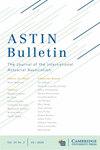ESTIMATION OF FUTURE DISCRETIONARY BENEFITS IN TRADITIONAL LIFE INSURANCE
IF 1.8
3区 经济学
Q2 ECONOMICS
引用次数: 2
Abstract
Abstract In the context of life insurance with profit participation, the future discretionary benefits (FDB), which are a central item for Solvency II reporting, are generally calculated by computationally expensive Monte Carlo algorithms. We derive analytic formulas to estimate lower and upper bounds for the FDB. This yields an estimation interval for the FDB, and the average of lower and upper bound is a simple estimator. These formulae are designed for real world applications, and we compare the results to publicly available reporting data.传统寿险中未来可自由支配利益的估计
摘要在利润参与寿险的背景下,未来可自由支配收益(FDB)是偿付能力II报告的核心项目,通常通过计算昂贵的蒙特卡罗算法计算。我们导出了估计FDB下界和上界的解析公式。这产生了FDB的估计区间,下界和上界的平均值是一个简单的估计量。这些公式是为现实世界的应用而设计的,我们将结果与公开可用的报告数据进行比较。
本文章由计算机程序翻译,如有差异,请以英文原文为准。
求助全文
约1分钟内获得全文
求助全文
来源期刊

ASTIN Bulletin
数学-数学跨学科应用
CiteScore
3.20
自引率
5.30%
发文量
24
审稿时长
>12 weeks
期刊介绍:
ASTIN Bulletin publishes papers that are relevant to any branch of actuarial science and insurance mathematics. Its papers are quantitative and scientific in nature, and draw on theory and methods developed in any branch of the mathematical sciences including actuarial mathematics, statistics, probability, financial mathematics and econometrics.
 求助内容:
求助内容: 应助结果提醒方式:
应助结果提醒方式:


